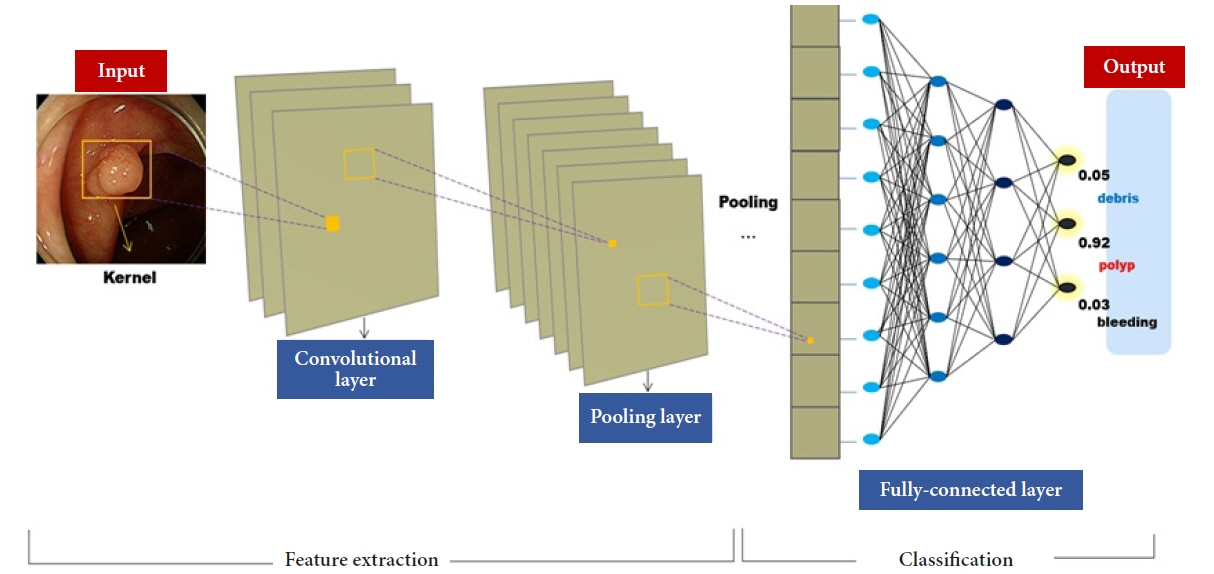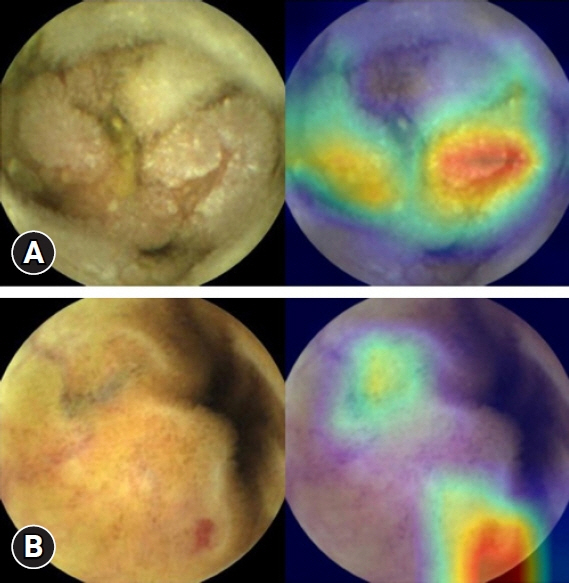Clin Endosc.
2022 Sep;55(5):594-604. 10.5946/ce.2021.229.
Preparation of image databases for artificial intelligence algorithm development in gastrointestinal endoscopy
- Affiliations
-
- 1Department of Internal Medicine, Dongguk University Ilsan Hospital, Dongguk University College of Medicine, Goyang, Korea
- KMID: 2533297
- DOI: http://doi.org/10.5946/ce.2021.229
Abstract
- Over the past decade, technological advances in deep learning have led to the introduction of artificial intelligence (AI) in medical imaging. The most commonly used structure in image recognition is the convolutional neural network, which mimics the action of the human visual cortex. The applications of AI in gastrointestinal endoscopy are diverse. Computer-aided diagnosis has achieved remarkable outcomes with recent improvements in machine-learning techniques and advances in computer performance. Despite some hurdles, the implementation of AI-assisted clinical practice is expected to aid endoscopists in real-time decision-making. In this summary, we reviewed state-of-the-art AI in the field of gastrointestinal endoscopy and offered a practical guide for building a learning image dataset for algorithm development.
Keyword
Figure
Cited by 1 articles
-
As how artificial intelligence is revolutionizing endoscopy
Jean-Francois Rey
Clin Endosc. 2024;57(3):302-308. doi: 10.5946/ce.2023.230.
Reference
-
1. Ruffle JK, Farmer AD, Aziz Q. Artificial intelligence-assisted gastroenterology- promises and pitfalls. Am J Gastroenterol. 2019; 114:422–428.2. Samuel AL. Some studies in machine learning using the game of checkers. IBM J Res Dev. 1959; 3:210–229.3. Rajkomar A, Dean J, Kohane I. Machine learning in medicine. N Engl J Med. 2019; 380:1347–1358.4. McCulloch WS, Pitts W. A logical calculus of the ideas immanent in nervous activity. 1943. Bull Math Biol. 1990; 52:99–115.5. Litjens G, Ciompi F, Wolterink JM, et al. State-of-the-art deep learning in cardiovascular image analysis. JACC Cardiovasc Imaging. 2019; 12:1549–1565.6. Hinton GE, Salakhutdinov RR. Reducing the dimensionality of data with neural networks. Science. 2006; 313:504–507.7. Le Cun Y, Boser B, Denker JS, et al. Handwritten digit recognition with a back-propagation network. In : Touretzky DS, editor. Advances in neural information processing systems 2. San Francisco (CA): Morgan Kaufmann Publishers Inc.;1990. p. 396–404.8. Ahmad OF, Soares AS, Mazomenos E, et al. Artificial intelligence and computer-aided diagnosis in colonoscopy: current evidence and future directions. Lancet Gastroenterol Hepatol. 2019; 4:71–80.9. Krizhevsky A, Sutskever I, Hinton GE. ImageNet classification with deep convolutional neural networks. Commun ACM. 2017; 60:84–90.10. He K, Zhang X, Ren S, et al. Deep residual learning for image recognition. In : 2016 IEEE Conference on Computer Vision and Pattern Recognition (CVPR); 2016 Jun 27-30; Las Vegas, NV. p. 770–778.11. Litjens G, Kooi T, Bejnordi BE, et al. A survey on deep learning in medical image analysis. Med Image Anal. 2017; 42:60–88.12. Topol EJ. High-performance medicine: the convergence of human and artificial intelligence. Nat Med. 2019; 25:44–56.13. Billah M, Waheed S, Rahman MM. An automatic gastrointestinal polyp detection system in video endoscopy using fusion of color wavelet and convolutional neural network features. Int J Biomed Imaging. 2017; 2017:9545920.14. Zhang R, Zheng Y, Mak TW, et al. Automatic detection and classification of colorectal polyps by transferring low-level CNN features from nonmedical domain. IEEE J Biomed Health Inform. 2017; 21:41–47.15. Byrne MF, Chapados N, Soudan F, et al. Real-time differentiation of adenomatous and hyperplastic diminutive colorectal polyps during analysis of unaltered videos of standard colonoscopy using a deep learning model. Gut. 2019; 68:94–100.16. Repici A, Badalamenti M, Maselli R, et al. Efficacy of real-time computer-aided detection of colorectal neoplasia in a randomized trial. Gastroenterology. 2020; 159:512–520.e7.17. Komeda Y, Handa H, Matsui R, et al. Artificial intelligence-based endoscopic diagnosis of colorectal polyps using residual networks. PLoS One. 2021; 16:e0253585.18. Misawa M, Kudo SE, Mori Y, et al. Artificial intelligence-assisted polyp detection for colonoscopy: initial experience. Gastroenterology. 2018; 154:2027–2029.e3.19. Wang P, Xiao X, Glissen Brown JR, et al. Development and validation of a deep-learning algorithm for the detection of polyps during colonoscopy. Nat Biomed Eng. 2018; 2:741–748.20. Itoh T, Kawahira H, Nakashima H, et al. Deep learning analyzes Helicobacter pylori infection by upper gastrointestinal endoscopy images. Endosc Int Open. 2018; 6:E139–E144.21. Shichijo S, Nomura S, Aoyama K, et al. Application of convolutional neural networks in the diagnosis of Helicobacter pylori infection based on endoscopic images. EBioMedicine. 2017; 25:106–111.22. Kudo SE, Misawa M, Mori Y, et al. Artificial intelligence-assisted system improves endoscopic identification of colorectal neoplasms. Clin Gastroenterol Hepatol. 2020; 18:1874–1881.e2.23. van der Sommen F, Zinger S, Curvers WL, et al. Computer-aided detection of early neoplastic lesions in Barrett’s esophagus. Endoscopy. 2016; 48:617–624.24. Horie Y, Yoshio T, Aoyama K, et al. Diagnostic outcomes of esophageal cancer by artificial intelligence using convolutional neural networks. Gastrointest Endosc. 2019; 89:25–32.25. Kanesaka T, Lee TC, Uedo N, et al. Computer-aided diagnosis for identifying and delineating early gastric cancers in magnifying narrow-band imaging. Gastrointest Endosc. 2018; 87:1339–1344.26. Wu L, Zhou W, Wan X, et al. A deep neural network improves endoscopic detection of early gastric cancer without blind spots. Endoscopy. 2019; 51:522–531.27. Zhu Y, Wang QC, Xu MD, et al. Application of convolutional neural network in the diagnosis of the invasion depth of gastric cancer based on conventional endoscopy. Gastrointest Endosc. 2019; 89:806–815.28. Ding Z, Shi H, Zhang H, et al. Gastroenterologist-level identification of small-bowel diseases and normal variants by capsule endoscopy using a deep-learning model. Gastroenterology. 2019; 157:1044–1054.29. Li P, Li Z, Gao F, et al. Convolutional neural networks for intestinal hemorrhage detection in wireless capsule endoscopy images. In : 2017 IEEE International Conference on Multimedia and Expo (ICME); 2017 Jul 10-14; Hong Kong, China. p. 1518–1523.30. Aoki T, Yamada A, Aoyama K, et al. Automatic detection of erosions and ulcerations in wireless capsule endoscopy images based on a deep convolutional neural network. Gastrointest Endosc. 2019; 89:357–363.e2.31. Klang E, Barash Y, Margalit RY, et al. Deep learning algorithms for automated detection of Crohn’s disease ulcers by video capsule endoscopy. Gastrointest Endosc. 2020; 91:606–613.32. Corley DA, Levin TR, Doubeni CA. Adenoma detection rate and risk of colorectal cancer and death. N Engl J Med. 2014; 370:2539–2541.33. Urban G, Tripathi P, Alkayali T, et al. Deep learning localizes and identifies polyps in real time with 96% accuracy in screening colonoscopy. Gastroenterology. 2018; 155:1069–1078.e8.34. Gong EJ, Lee JH, Jung K, et al. Characteristics of missed simultaneous gastric lesions based on double-check analysis of the endoscopic image. Clin Endosc. 2017; 50:261–269.35. Lui TK, Tsui VW, Leung WK. Accuracy of artificial intelligence-assisted detection of upper GI lesions: a systematic review and meta-analysis. Gastrointest Endosc. 2020; 92:821–830.e9.36. Alsop BR, Sharma P. Esophageal cancer. Gastroenterol Clin North Am. 2016; 45:399–412.37. Kiesslich R, Burg J, Vieth M, et al. Confocal laser endoscopy for diagnosing intraepithelial neoplasias and colorectal cancer in vivo. Gastroenterology. 2004; 127:706–713.38. Mori Y, Kudo S, Ikehara N, et al. Comprehensive diagnostic ability of endocytoscopy compared with biopsy for colorectal neoplasms: a prospective randomized noninferiority trial. Endoscopy. 2013; 45:98–105.39. Kim SH, Yang DH, Kim JS. Current status of interpretation of small bowel capsule endoscopy. Clin Endosc. 2018; 51:329–333.40. Nam SJ, Lim YJ, Nam JH, et al. 3D reconstruction of small bowel lesions using stereo camera-based capsule endoscopy. Sci Rep. 2020; 10:6025.41. Oh DJ, Kim KS, Lim YJ. A new active locomotion capsule endoscopy under magnetic control and automated reading program. Clin Endosc. 2020; 53:395–401.42. Milluzzo SM, Cesaro P, Grazioli LM, et al. Artificial Intelligence in lower gastrointestinal endoscopy: the current status and future perspective. Clin Endosc. 2021; 54:329–339.43. Stidham RW, Liu W, Bishu S, et al. Performance of a deep learning model vs human reviewers in grading endoscopic disease severity of patients with ulcerative colitis. JAMA Netw Open. 2019; 2:e193963.44. Maeda Y, Kudo SE, Mori Y, et al. Fully automated diagnostic system with artificial intelligence using endocytoscopy to identify the presence of histologic inflammation associated with ulcerative colitis (with video). Gastrointest Endosc. 2019; 89:408–415.45. Ozawa T, Ishihara S, Fujishiro M, et al. Novel computer-assisted diagnosis system for endoscopic disease activity in patients with ulcerative colitis. Gastrointest Endosc. 2019; 89:416–421.e1.46. Liu Y, Chen PC, Krause J, et al. How to read articles that use machine learning: users’ guides to the medical literature. JAMA. 2019; 322:1806–1816.47. Eelbode T, Sinonquel P, Maes F, et al. Pitfalls in training and validation of deep learning systems. Best Pract Res Clin Gastroenterol. 2021; 52-53:101712.48. der Pol CBV, Tang A. Imaging database preparation for machine learning. Can Assoc Radiol J. 2021; 72:9–10.49. Sutton RA, Sharma P. Overcoming barriers to implementation of artificial intelligence in gastroenterology. Best Pract Res Clin Gastroenterol. 2021; 52-53:101732.50. Pannala R, Krishnan K, Melson J, et al. Artificial intelligence in gastrointestinal endoscopy. VideoGIE. 2020; 5:598–613.51. Berzin TM, Topol EJ. Adding artificial intelligence to gastrointestinal endoscopy. Lancet. 2020; 395:485.
- Full Text Links
- Actions
-
Cited
- CITED
-
- Close
- Share
- Similar articles
-
- Application of artificial intelligence for diagnosis of early gastric cancer based on magnifying endoscopy with narrow-band imaging
- Role of artificial intelligence in diagnosing Barrett’s esophagus-related neoplasia
- The Latest Trends in the Use of Deep Learning in Radiology Illustrated Through the Stages of Deep Learning Algorithm Development
- Deep Learning in Upper Gastrointestinal Disorders: Status and Future Perspectives
- Overview of Deep Learning in Gastrointestinal Endoscopy




